Qiong Zhang
Gaussian Herding across Pens: An Optimal Transport Perspective on Global Gaussian Reduction for 3DGS
Jun 11, 2025



Abstract:3D Gaussian Splatting (3DGS) has emerged as a powerful technique for radiance field rendering, but it typically requires millions of redundant Gaussian primitives, overwhelming memory and rendering budgets. Existing compaction approaches address this by pruning Gaussians based on heuristic importance scores, without global fidelity guarantee. To bridge this gap, we propose a novel optimal transport perspective that casts 3DGS compaction as global Gaussian mixture reduction. Specifically, we first minimize the composite transport divergence over a KD-tree partition to produce a compact geometric representation, and then decouple appearance from geometry by fine-tuning color and opacity attributes with far fewer Gaussian primitives. Experiments on benchmark datasets show that our method (i) yields negligible loss in rendering quality (PSNR, SSIM, LPIPS) compared to vanilla 3DGS with only 10% Gaussians; and (ii) consistently outperforms state-of-the-art 3DGS compaction techniques. Notably, our method is applicable to any stage of vanilla or accelerated 3DGS pipelines, providing an efficient and agnostic pathway to lightweight neural rendering.
TabPFN: One Model to Rule Them All?
May 26, 2025Abstract:Hollmann et al. (Nature 637 (2025) 319-326) recently introduced TabPFN, a transformer-based deep learning model for regression and classification on tabular data, which they claim "outperforms all previous methods on datasets with up to 10,000 samples by a wide margin, using substantially less training time." Furthermore, they have called TabPFN a "foundation model" for tabular data, as it can support "data generation, density estimation, learning reusable embeddings and fine-tuning". If these statements are well-supported, TabPFN may have the potential to supersede existing modeling approaches on a wide range of statistical tasks, mirroring a similar revolution in other areas of artificial intelligence that began with the advent of large language models. In this paper, we provide a tailored explanation of how TabPFN works for a statistics audience, by emphasizing its interpretation as approximate Bayesian inference. We also provide more evidence of TabPFN's "foundation model" capabilities: We show that an out-of-the-box application of TabPFN vastly outperforms specialized state-of-the-art methods for semi-supervised parameter estimation, prediction under covariate shift, and heterogeneous treatment effect estimation. We further show that TabPFN can outperform LASSO at sparse regression and can break a robustness-efficiency trade-off in classification. All experiments can be reproduced using the code provided at https://github.com/qinglong-tian/tabpfn_study (https://github.com/qinglong-tian/tabpfn_study).
CliniChat: A Multi-Source Knowledge-Driven Framework for Clinical Interview Dialogue Reconstruction and Evaluation
Apr 14, 2025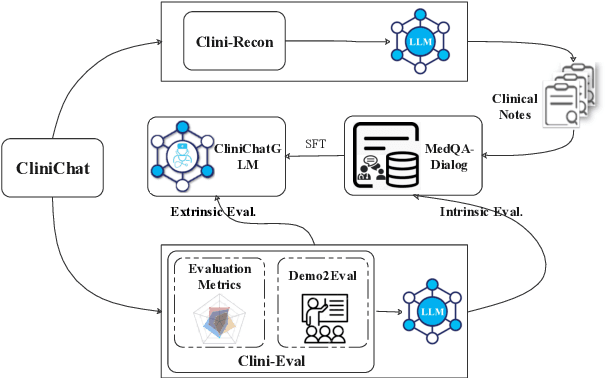
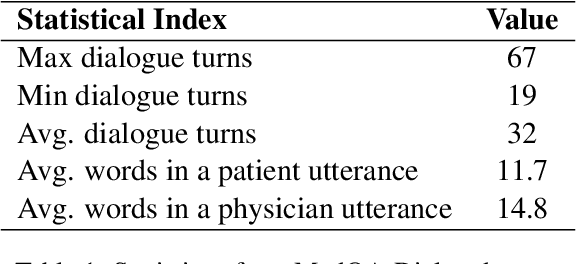
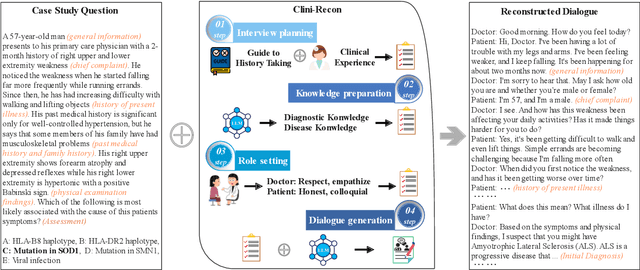

Abstract:Large language models (LLMs) hold great promise for assisting clinical interviews due to their fluent interactive capabilities and extensive medical knowledge. However, the lack of high-quality interview dialogue data and widely accepted evaluation methods has significantly impeded this process. So we propose CliniChat, a framework that integrates multi-source knowledge to enable LLMs to simulate real-world clinical interviews. It consists of two modules: Clini-Recon and Clini-Eval, each responsible for reconstructing and evaluating interview dialogues, respectively. By incorporating three sources of knowledge, Clini-Recon transforms clinical notes into systematic, professional, and empathetic interview dialogues. Clini-Eval combines a comprehensive evaluation metric system with a two-phase automatic evaluation approach, enabling LLMs to assess interview performance like experts. We contribute MedQA-Dialog, a high-quality synthetic interview dialogue dataset, and CliniChatGLM, a model specialized for clinical interviews. Experimental results demonstrate that CliniChatGLM's interview capabilities undergo a comprehensive upgrade, particularly in history-taking, achieving state-of-the-art performance.
Just a Few Glances: Open-Set Visual Perception with Image Prompt Paradigm
Dec 14, 2024



Abstract:To break through the limitations of pre-training models on fixed categories, Open-Set Object Detection (OSOD) and Open-Set Segmentation (OSS) have attracted a surge of interest from researchers. Inspired by large language models, mainstream OSOD and OSS methods generally utilize text as a prompt, achieving remarkable performance. Following SAM paradigm, some researchers use visual prompts, such as points, boxes, and masks that cover detection or segmentation targets. Despite these two prompt paradigms exhibit excellent performance, they also reveal inherent limitations. On the one hand, it is difficult to accurately describe characteristics of specialized category using textual description. On the other hand, existing visual prompt paradigms heavily rely on multi-round human interaction, which hinders them being applied to fully automated pipeline. To address the above issues, we propose a novel prompt paradigm in OSOD and OSS, that is, \textbf{Image Prompt Paradigm}. This brand new prompt paradigm enables to detect or segment specialized categories without multi-round human intervention. To achieve this goal, the proposed image prompt paradigm uses just a few image instances as prompts, and we propose a novel framework named \textbf{MI Grounding} for this new paradigm. In this framework, high-quality image prompts are automatically encoded, selected and fused, achieving the single-stage and non-interactive inference. We conduct extensive experiments on public datasets, showing that MI Grounding achieves competitive performance on OSOD and OSS benchmarks compared to text prompt paradigm methods and visual prompt paradigm methods. Moreover, MI Grounding can greatly outperform existing method on our constructed specialized ADR50K dataset.
Byzantine-tolerant distributed learning of finite mixture models
Jul 19, 2024Abstract:This paper proposes two split-and-conquer (SC) learning estimators for finite mixture models that are tolerant to Byzantine failures. In SC learning, individual machines obtain local estimates, which are then transmitted to a central server for aggregation. During this communication, the server may receive malicious or incorrect information from some local machines, a scenario known as Byzantine failures. While SC learning approaches have been devised to mitigate Byzantine failures in statistical models with Euclidean parameters, developing Byzantine-tolerant methods for finite mixture models with non-Euclidean parameters requires a distinct strategy. Our proposed distance-based methods are hyperparameter tuning free, unlike existing methods, and are resilient to Byzantine failures while achieving high statistical efficiency. We validate the effectiveness of our methods both theoretically and empirically via experiments on simulated and real data from machine learning applications for digit recognition. The code for the experiment can be found at https://github.com/SarahQiong/RobustSCGMM.
Toward a More Biologically Plausible Neural Network Model of Latent Cause Inference
Dec 13, 2023Abstract:Humans spontaneously perceive a continuous stream of experience as discrete events. It has been hypothesized that this ability is supported by latent cause inference (LCI). We implemented this hypothesis using Latent Cause Network (LCNet), a neural network model of LCI. LCNet interacts with a Bayesian LCI mechanism that activates a unique context vector for each inferred latent cause. This architecture makes LCNet more biologically plausible than existing models of LCI and supports extraction of shared structure across latent causes. Across three simulations, we found that LCNet could 1) extract shared structure across latent causes in a function-learning task while avoiding catastrophic interference, 2) capture human data on curriculum effects in schema learning, and 3) infer the underlying event structure when processing naturalistic videos of daily activities. Our work provides a biologically plausible computational model that can operate in both laboratory experiment settings and naturalistic settings, opening up the possibility of providing a unified model of event cognition.
How should the advent of large language models affect the practice of science?
Dec 05, 2023Abstract:Large language models (LLMs) are being increasingly incorporated into scientific workflows. However, we have yet to fully grasp the implications of this integration. How should the advent of large language models affect the practice of science? For this opinion piece, we have invited four diverse groups of scientists to reflect on this query, sharing their perspectives and engaging in debate. Schulz et al. make the argument that working with LLMs is not fundamentally different from working with human collaborators, while Bender et al. argue that LLMs are often misused and over-hyped, and that their limitations warrant a focus on more specialized, easily interpretable tools. Marelli et al. emphasize the importance of transparent attribution and responsible use of LLMs. Finally, Botvinick and Gershman advocate that humans should retain responsibility for determining the scientific roadmap. To facilitate the discussion, the four perspectives are complemented with a response from each group. By putting these different perspectives in conversation, we aim to bring attention to important considerations within the academic community regarding the adoption of LLMs and their impact on both current and future scientific practices.
Forgettable Federated Linear Learning with Certified Data Removal
Jun 03, 2023



Abstract:Federated learning (FL) is a trending distributed learning framework that enables collaborative model training without data sharing. Machine learning models trained on datasets can potentially expose the private information of the training data, revealing details about individual data records. In this study, we focus on the FL paradigm that grants clients the ``right to be forgotten''. The forgettable FL framework should bleach its global model weights as it has never seen that client and hence does not reveal any information about the client. To this end, we propose the Forgettable Federated Linear Learning (2F2L) framework featured with novel training and data removal strategies. The training pipeline, named Federated linear training, employs linear approximation on the model parameter space to enable our 2F2L framework work for deep neural networks while achieving comparable results with canonical neural network training. We also introduce FedRemoval, an efficient and effective removal strategy that tackles the computational challenges in FL by approximating the Hessian matrix using public server data from the pretrained model. Unlike the previous uncertified and heuristic machine unlearning methods in FL, we provide theoretical guarantees by bounding the differences of model weights by our FedRemoval and that from retraining from scratch. Experimental results on MNIST and Fashion-MNIST datasets demonstrate the effectiveness of our method in achieving a balance between model accuracy and information removal, outperforming baseline strategies and approaching retraining from scratch.
FedMT: Federated Learning with Mixed-type Labels
Oct 05, 2022
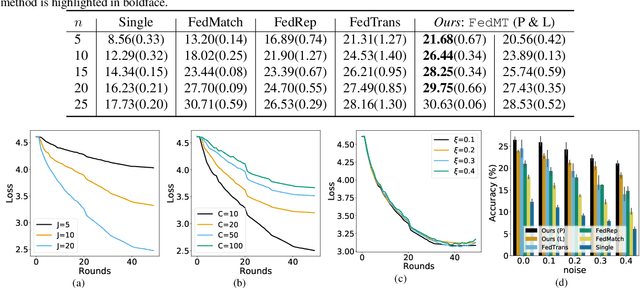

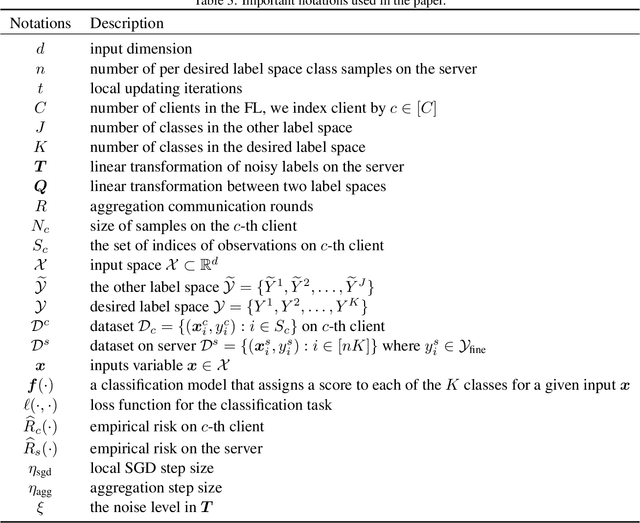
Abstract:In federated learning (FL), classifiers (e.g., deep networks) are trained on datasets from multiple centers without exchanging data across them, and thus improves sample efficiency. In the classical setting of FL, the same labeling criterion is usually employed across all centers being involved in training. This constraint greatly limits the applicability of FL. For example, standards used for disease diagnosis are more likely to be different across clinical centers, which mismatches the classical FL setting. In this paper, we consider an important yet under-explored setting of FL, namely FL with mixed-type labels where different labeling criteria can be employed by various centers, leading to inter-center label space differences and challenging existing FL methods designed for the classical setting. To effectively and efficiently train models with mixed-type labels, we propose a theory-guided and model-agnostic approach that can make use of the underlying correspondence between those label spaces and can be easily combined with various FL methods such as FedAvg. We present convergence analysis based on over-parameterized ReLU networks. We show that the proposed method can achieve linear convergence in label projection, and demonstrate the impact of the parameters of our new setting on the convergence rate. The proposed method is evaluated and the theoretical findings are validated on benchmark and medical datasets.
Reinforced Structured State-Evolution for Vision-Language Navigation
Apr 20, 2022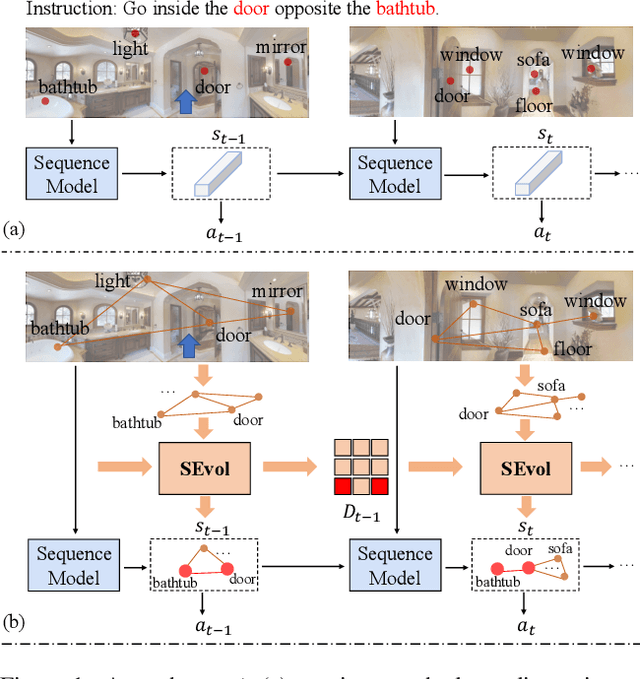
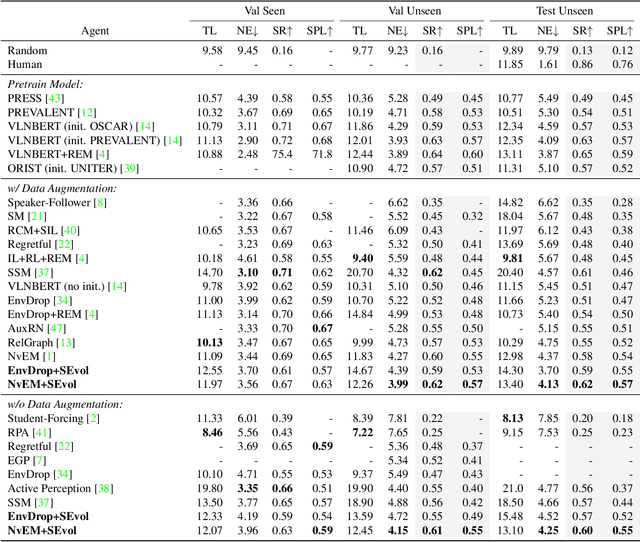
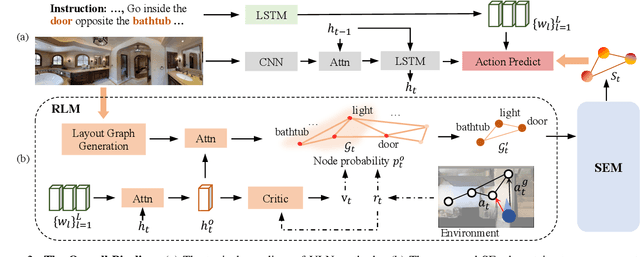

Abstract:Vision-and-language Navigation (VLN) task requires an embodied agent to navigate to a remote location following a natural language instruction. Previous methods usually adopt a sequence model (e.g., Transformer and LSTM) as the navigator. In such a paradigm, the sequence model predicts action at each step through a maintained navigation state, which is generally represented as a one-dimensional vector. However, the crucial navigation clues (i.e., object-level environment layout) for embodied navigation task is discarded since the maintained vector is essentially unstructured. In this paper, we propose a novel Structured state-Evolution (SEvol) model to effectively maintain the environment layout clues for VLN. Specifically, we utilise the graph-based feature to represent the navigation state instead of the vector-based state. Accordingly, we devise a Reinforced Layout clues Miner (RLM) to mine and detect the most crucial layout graph for long-term navigation via a customised reinforcement learning strategy. Moreover, the Structured Evolving Module (SEM) is proposed to maintain the structured graph-based state during navigation, where the state is gradually evolved to learn the object-level spatial-temporal relationship. The experiments on the R2R and R4R datasets show that the proposed SEvol model improves VLN models' performance by large margins, e.g., +3% absolute SPL accuracy for NvEM and +8% for EnvDrop on the R2R test set.
 Add to Chrome
Add to Chrome Add to Firefox
Add to Firefox Add to Edge
Add to Edge